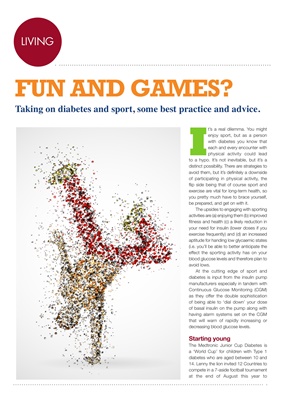
LIVINGLIVINGNEWS
FUN AND GAMES?
Taking on diabetes and sport, some best practice and advice.
LIVING
It's a real dilemma. You might
enjoy sport, but as a person
with diabetes you know that
each and every encounter with
physical activity could lead
to a hypo. It's not inevitable, but it's a
distinct possibility. There are strategies to
avoid them, but it's definitely a downside
of participating in physical activity, the
flip side being that of course sport and
exercise are vital for long-term health, so
you pretty much have to brace yourself,
be prepared, and get on with it.
The upsides to engaging with sporting
activities are (a) enjoying them (b) improved
fitness and health (c) a likely reduction in
your need for insulin (lower doses if you
exercise frequently) and (d) an increased
aptitude for handing low glycaemic states
(i.e. you'll be able to better anticipate the
effect the sporting activity has on your
blood glucose levels and therefore plan to
avoid lows.
At the cutting edge of sport and
diabetes is input from the insulin pump
manufacturers especially in tandem with
Continuous Glucose Monitoring (CGM)
as they offer the double sophistication
of being able to 'dial down' your dose
of basal insulin on the pump along with
having alarm systems set on the CGM
that will warn of rapidly increasing or
decreasing blood glucose levels.
Starting young
The Medtronic Junior Cup Diabetes is
a 'World Cup' for children with Type 1
diabetes who are aged between 10 and
14. Lenny the lion invited 12 Countries to
compete in a 7-aside football tournament
at the end of August this year to